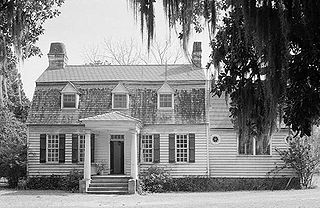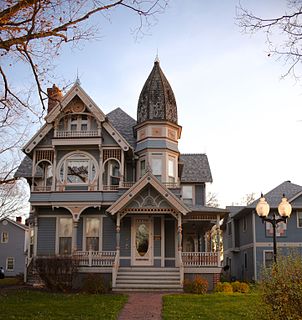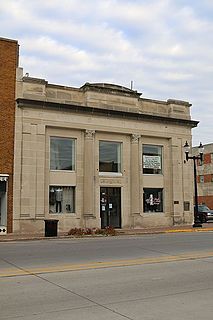
The Charles Pinckney National Historic Site is a unit of the United States National Park Service, preserving a portion of Charles Pinckney's Snee Farm plantation and country retreat. The site is located at 1254 Long Point Road, Mount Pleasant, South Carolina. Pinckney (1757-1824) was a member of a prominent political family in South Carolina. He fought in the American Revolutionary War, was held for a period as prisoner in the North, and returned to the state in 1783. Pinckney served as a delegate to the constitutional convention where he contributed to drafting the United States Constitution.

Mount Pleasant is a historic mansion in Philadelphia, Pennsylvania, atop cliffs overlooking the Schuylkill River. It was built about 1761–62 in what was then the countryside outside the city by John Macpherson and his wife Margaret. Macpherson was a privateer, or perhaps a pirate, who had had "an arm twice shot off" according to John Adams. He named the house "Clunie" after the ancient seat of his family's clan in Scotland.

The Benjamin Lundy House is a historic house at Union and Market Streets in Mount Pleasant, Ohio. It was home in 1820 to abolitionist Benjamin Lundy (1789-1839), where he established the influential antislavery newspaper The Genius of Universal Emancipation, one of the first antislavery publications in the United States. It was designated a National Historic Landmark in May 1974, and included in the Mount Pleasant Historic District later the same year.

The Oakland Plantation House which is also known as Youghall or Youghal Plantation House, was built about 1750 in Charleston County, South Carolina about 7 mi (11 km) east of Mount Pleasant. It is located about 1 mile (1.6 km) south of U.S. Route 17 on Stratton Place. It was named to the National Register of Historic Places on July 13, 1977.

Mount Pleasant Armory was a historic National Guard armory located at Mount Pleasant, Westmoreland County, Pennsylvania. It was designed by W.G. Wilkins Co.. It was built in 1906, and was a two-story, "T"-shaped brick building executed in the Romanesque style. It had a flat roof over the administrative section and a gambrel roof over the drill hall.

Mount Pleasant is an unincorporated community located along County Route 519 on the border of Alexandria Township and Holland Township, in Hunterdon County, New Jersey. The Mount Pleasant Historic District was listed on the National Register of Historic Places in 1987.

The Dr. J.O. and Catherine Ball House is a historic building located in Mount Pleasant, Iowa, United States. In 1892 this was one of three houses designed by George F. Barber's mail-order architectural firm that was being built in town, and it was the most elaborate of the three. The house is an enlargement of Barber's more expensive plans for design no. 33 from his 1891 book. The 2½-story frame Queen Anne features an irregular plan, a brick-faced limestone foundation, and an octagonal tower with an ogee shaped roof. The circular window on the second story projection is framed with three balconies, one above and one on either side. The wrap-around porch has a projecting gable roof supported by turned columns. A two-story bay window is located on the east elevation. It was also the first house in Mount Pleasant that was totally reliant on electricity for lighting. It was built for Dr. J.O. Ball, a dentist, who was active in civic improvements in Mount Pleasant. The house was listed on the National Register of Historic Places in 1986.

The George and Margaret Cooper House is a historic building located in Mount Pleasant, Iowa, United States. It is a fine example of the Italianate style, which was a popular style for residential architecture in Mount Pleasant from the 1850s to the mid-1880s The two-story brick house features an asymmetrical plan, a low-pitched hip roof, wide bracketed eaves, and long, narrow windows. The full-width front porch has square paneled columns with foliate designs in the capitals and brackets. A single-story wing is attached to the rear of the house. A two-story, five sided wing was added to the west side of the house about ten years after the main part of the house was built. The house was built for George Cooper, a taylor, and it remained in his family until 1921. It was listed on the National Register of Historic Places in 1997.

The Brazelton House Hotel is a historic building located in Mount Pleasant, Iowa, United States. William P. Brazelton was an early leader in the city's development. He owned the Brazelton Banking House and he was one of the directors of the Brazelton House Company, which built the hotel. It is not clear, specifically, why the hotel bears his family name. The construction of the hotel in 1856 coincided with a building boom in Mount Pleasant with the extension of the Burlington and Missouri River Railroad into town. It was built with the belief that Mount Pleasant would need a large first class hotel, but it had financial problems from the beginning and went through a series of owners until it no longer functioned as a hotel about 1970. The building was listed on the National Register of Historic Places in 1986. In 2015 the upper floors were converted into apartments while the main floor continued to house retail businesses.

Mount Pleasant City Hall is the official seat of government of the city of Mount Pleasant, Iowa, United States. This 1½-story stone structure was designed by Burlington, Iowa architect William Weibley, and constructed by local builder K.A. Bergdahl. It is an eclectic combination of Colonial Revival styles. For the most part it reflects Georgian Revival aesthetics with its symmetrical facade and the pilasters that flank the main entrance. The stepped ends of the gable roof and the projecting gable above the main entrance reflect the Dutch Revival influence. The random ashlar stone used in its construction was salvaged from the Seeley Memorial YMCA-high school that was destroyed in a 1932 fire. The city hall's construction in 1936 was a Works Progress Administration project. The east wing, which has been altered from its original appearance, originally housed the city's police and fire departments before they moved to their own buildings. City hall was listed on the National Register of Historic Places in 1991.

First National Bank is a historic building located in Mount Pleasant, Iowa, United States. The bank was first located on this corner in the 1860s. Its first building was a small, brick Italianate structure. This building replaced it in 1923. It is a two-story stone structure designed by Chicago architect Paul V. Hyland in the Neoclassical style. It is unique in Mount Pleasant in that it is the only stone building facing the square, and it reflects more of a public building instead of a commercial building. It is similar in style to the Henry County Courthouse, which is diagonally across the square. The exterior of the primary and secondary facades is composed of ashlar limestone and features paired pilasters on the corners of the primary facade, and a single column in the Corinthian order that flank the main entrance. It is capped with a simple classical cornice and parapet roof. The alley side of the building is composed of red brick. The building was listed on the National Register of Historic Places in 1991.

Henry County Savings Bank is a historic building located in Mount Pleasant, Iowa, United States. Because this two story, brick Italianate structure was built specifically as a bank, it features a chamfered corner, which was commonly used to designate a bank in the last quarter of the 19th century. Other features typical of an Italianate commercial building include segmental arched windows, a corbeled brick frieze, and a bracketed metal cornice. The building was listed on the National Register of Historic Places in 1991.

The Budde–Singer Building is a historic building located in Mount Pleasant, Iowa, United States. This three story, brick Italianate structure was built in 1882. It replaced a similar building that had been built in 1856 and destroyed in a fire. Its early Italianate style is unusual for this time period, but it fits into its streetscape with similarly designed buildings, including the neighboring Brazelton House Hotel. The Budde–Singer Building features round arched windows with brick patterned hoodmolds on the second and third floors, and a bracketed wooden cornice. The first floor storefront has been somewhat altered, and the exterior of the building has been painted since about 1909. It was listed on the National Register of Historic Places in 1991.

The Louisa Building is a historic building located in Mount Pleasant, Iowa, United States. Completed in 1901, this two story, brick structure features a transitional design between the Italianate, that had been popular here, and the Neoclassical that would replace it in popularity. It has a triple storefront with three sets of three windows on the second floor. In place of hood molds, which were typical of the Italianate, each window has a heavy rusticated stone lintel. The metal cornice across the top of the facade is simpler in its decorative elements than earlier Italianate cornices. This building replaced the Ambler Block, which had been destroyed in an 1882 fire. The lot had remained empty in the intervening years. The building was listed on the National Register of Historic Places in 1991.

The Masters Building is a historic building located in Mount Pleasant, Iowa, United States. Completed in 1937, this two story, brick structure is an adaptation of the commercial Art Deco and Art Moderne styles. The decorative elements are found in the brick patterning and cast concrete panels on the facade. There are three other buildings on this same block that were built about the same time and use the same decorative techniques, with the Masters Building being the best example. This area was an expansion of the central business district after the construction of city hall across the street in 1936. A plumbing business, for which this building was constructed, was located on the first floor. There are three apartments on the second floor. The building was listed on the National Register of Historic Places in 1991.

The McCandless Building is a historic building located in Mount Pleasant, Iowa, United States. This three story brick Italianate structure was built in 1862 by local builder William McCandless. With the arrival of the railroad in 1856, Mount Pleasant was in need of new commercial buildings to house businesses and services that were opening in the expanding town. They were built on the north and east side of the town square. The Italianate was a prominent style used in the city at this time having been used by about a dozen buildings. This buildings features three round arch windows on the second and third floors with brick patterned hood molds. The storefront has been altered slightly, and the heavy wooden cornice that graced the top of the main facade was removed some time ago. The building was listed on the National Register of Historic Places in 1991.

The Timmerman–Burd Building is a historic building located in Mount Pleasant, Iowa, United States. The previous building on this lot was destroyed in a fire in 1883 and Henry Timmerman had this building constructed to replace it the same year. The two story brick structure is one of several building facing the town square in the Italianate style. This buildings features a single storefront, and four segmental arch windows on the second floor with simple brick patterned hood molds. The bracketed metal cornice at the top of the main facade was mass-produced and likely ordered from a catalog. Burd worked for Timmerman and took over the business. This building housed a shoe store as late as the 1990s. It was listed on the National Register of Historic Places in 1991.

The Pleasant Lawn School Historic District is a nationally recognized historic district located northeast of Mount Pleasant, Iowa, United States. It was listed on the National Register of Historic Places in 1987. At the time of its nomination it consisted of three resources, all of which are contributing buildings. This is the only intact example of a consolidated rural school district in Iowa. It consists of a two-story brick school building (1917), a two-story frame teacherage (1917), and a hack barn. A gymnasium was added to the school building in 1941. The school was still in existence when the buildings were added to the National Register.

The Mount Pleasant High School Mechanical Arts Building, at 150 N. State St. in Mount Pleasant, Utah, was built in 1935. It was listed on the National Register of Historic Places in 1985.

The Moroni High School Mechanical Arts Building, at 350 N. Center St. in Moroni, Utah, was built in 1935–36. It was listed on the National Register of Historic Places in 1985.























